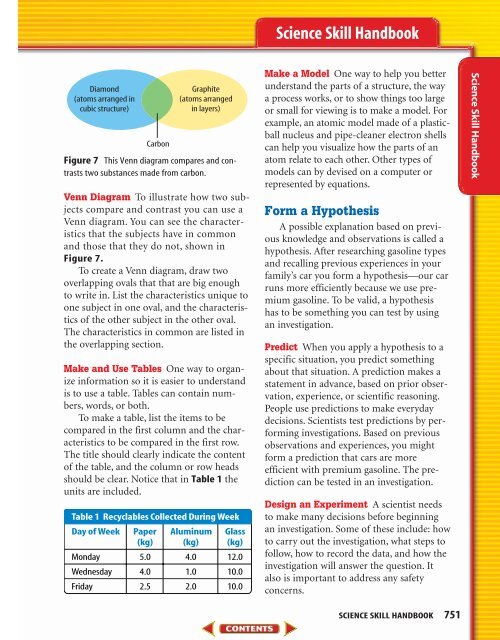Student Resources—746
Student Resources—746
Student Resources—746
You also want an ePaper? Increase the reach of your titles
YUMPU automatically turns print PDFs into web optimized ePapers that Google loves.
Diamond<br />
(atoms arranged in<br />
cubic structure)<br />
Carbon<br />
Graphite<br />
(atoms arranged<br />
in layers)<br />
Figure 7 This Venn diagram compares and contrasts<br />
two substances made from carbon.<br />
Venn Diagram To illustrate how two subjects<br />
compare and contrast you can use a<br />
Venn diagram. You can see the characteristics<br />
that the subjects have in common<br />
and those that they do not, shown in<br />
Figure 7.<br />
To create a Venn diagram, draw two<br />
overlapping ovals that that are big enough<br />
to write in. List the characteristics unique to<br />
one subject in one oval, and the characteristics<br />
of the other subject in the other oval.<br />
The characteristics in common are listed in<br />
the overlapping section.<br />
Make and Use Tables One way to organize<br />
information so it is easier to understand<br />
is to use a table. Tables can contain numbers,<br />
words, or both.<br />
To make a table, list the items to be<br />
compared in the first column and the characteristics<br />
to be compared in the first row.<br />
The title should clearly indicate the content<br />
of the table, and the column or row heads<br />
should be clear. Notice that in Table 1 the<br />
units are included.<br />
Table 1 Recyclables Collected During Week<br />
Day of Week Paper Aluminum Glass<br />
(kg) (kg) (kg)<br />
Monday 5.0 4.0 12.0<br />
Wednesday 4.0 1.0 10.0<br />
Friday 2.5 2.0 10.0<br />
Science Skill Handbook<br />
Make a Model One way to help you better<br />
understand the parts of a structure, the way<br />
a process works, or to show things too large<br />
or small for viewing is to make a model. For<br />
example, an atomic model made of a plasticball<br />
nucleus and pipe-cleaner electron shells<br />
can help you visualize how the parts of an<br />
atom relate to each other. Other types of<br />
models can by devised on a computer or<br />
represented by equations.<br />
Form a Hypothesis<br />
A possible explanation based on previous<br />
knowledge and observations is called a<br />
hypothesis. After researching gasoline types<br />
and recalling previous experiences in your<br />
family’s car you form a hypothesis—our car<br />
runs more efficiently because we use premium<br />
gasoline. To be valid, a hypothesis<br />
has to be something you can test by using<br />
an investigation.<br />
Predict When you apply a hypothesis to a<br />
specific situation, you predict something<br />
about that situation. A prediction makes a<br />
statement in advance, based on prior observation,<br />
experience, or scientific reasoning.<br />
People use predictions to make everyday<br />
decisions. Scientists test predictions by performing<br />
investigations. Based on previous<br />
observations and experiences, you might<br />
form a prediction that cars are more<br />
efficient with premium gasoline. The prediction<br />
can be tested in an investigation.<br />
Design an Experiment A scientist needs<br />
to make many decisions before beginning<br />
an investigation. Some of these include: how<br />
to carry out the investigation, what steps to<br />
follow, how to record the data, and how the<br />
investigation will answer the question. It<br />
also is important to address any safety<br />
concerns.<br />
SCIENCE SKILL HANDBOOK 751<br />
Science Skill Handbook
















